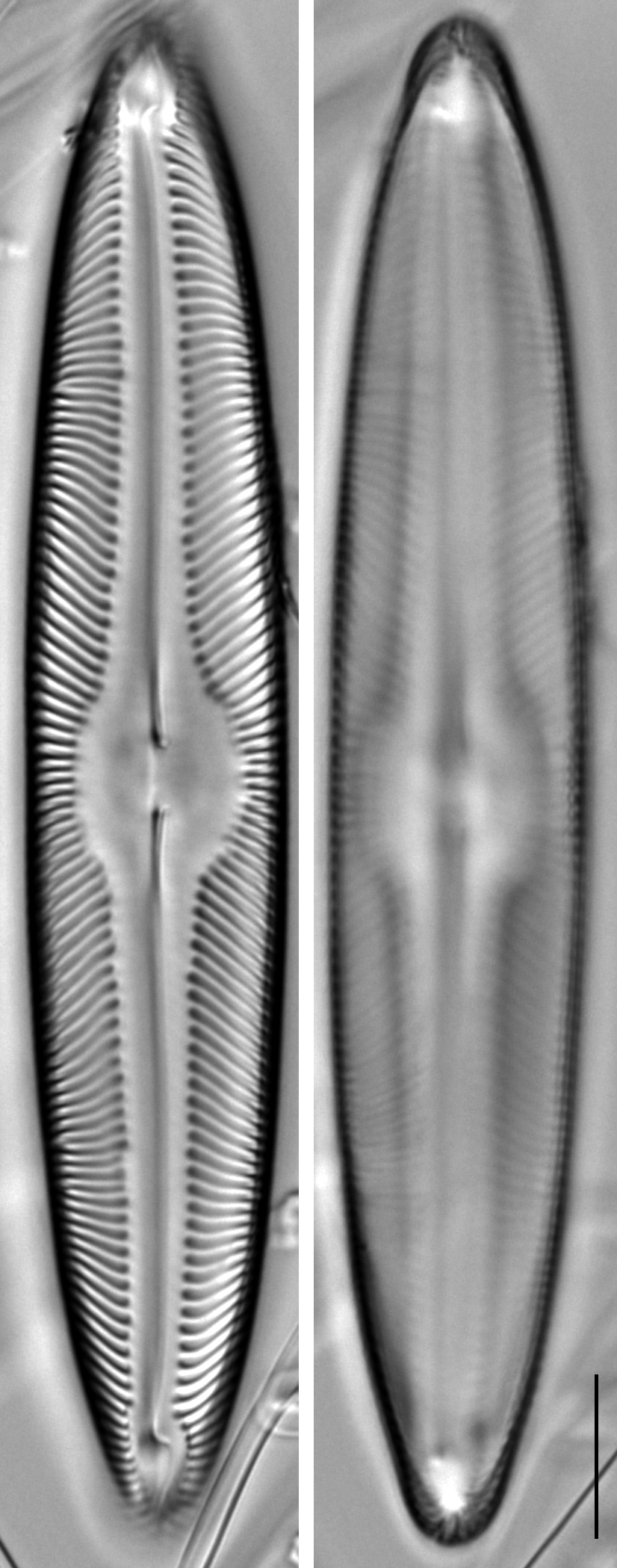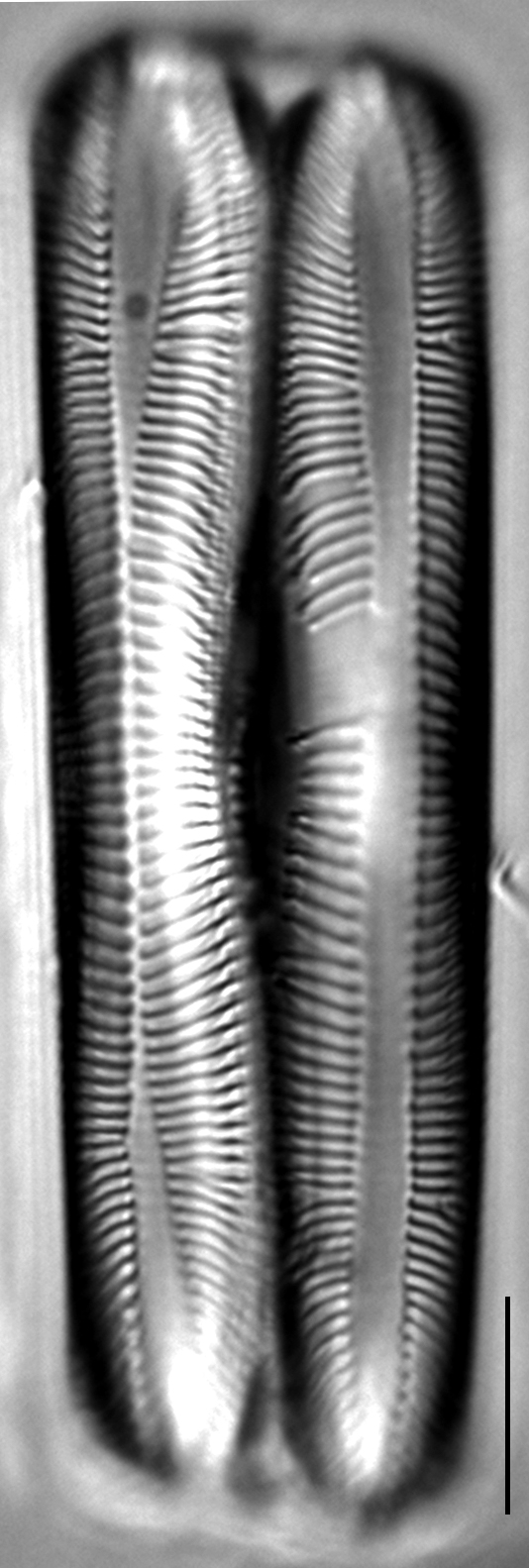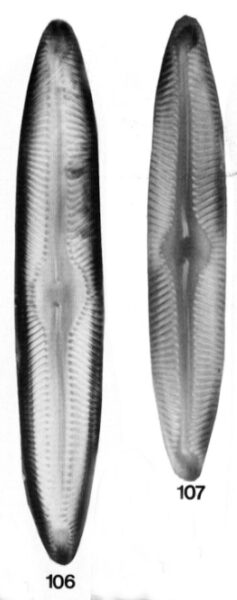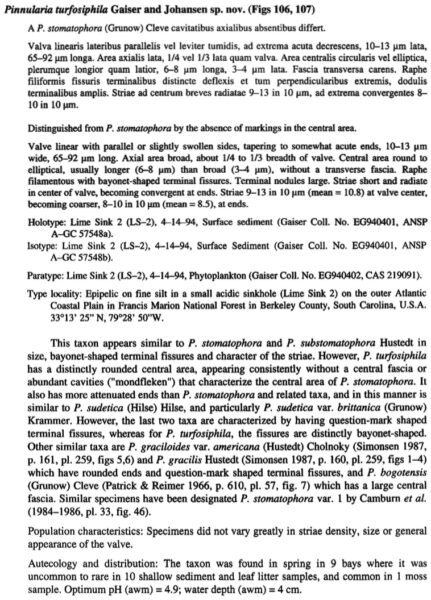Pinnularia turfosiphila
-
Category
-
Length Range66.9-95.5 µm
-
Width Range14-18 µm
-
Striae in 10 µm10-12
-
Reported AsPinnularia tumescens (Metzeltin and Lange-Bertalot 2007, pg. 734)
-
Contributor
-
ReviewerSylvia Lee - Oct 2016
Identification
Description
Valves are linear-lanceolate, with acutely rounded, tapered apices. The central area is elliptic and asymmetric about the apical axis. A fascia is absent. The striae are radiate at the valve center and become convergent at the apices. A Voight discontinuity is often present. The striae continue around the apices and the apical hyaline area. The raphe is lateral and the position of the raphe within the axial area is eccentric. The axial area narrows toward the apices. The distal raphe ends are curved, bayonet-shaped, and continue onto the mantle at the valve apices. A hyaline area surrounds the distal raphe ends. The external proximal raphe ends are slightly expanded into a teardrop shape. The internal proximal raphe ends form a short 90 degree hook.
Autecology
This taxon been reported from the eastern United States, in benthic habitats of low pH lakes (Gaiser and Johansen 2000, Siver and Hamilton 2011) and from Bear Meadows Bog, a low specific conductance, low pH wetland in Pennsylvania (Edlund and Brant 2010).
-
Size Range, µm3
-
Motility
-
Attachment
-
Habitat
-
Colony
-
Occurrence
-
Waterbody
-
Distribution
- Learn more about this
Original Description
Valve linear with parallel or slightly swollen sides, tapering to somewhat acute ends, 10-13 µm wide, 65-92 µm long. Axial area broad, about 1/4 to 1/3 breadth of valve. Central area round to elliptical, usually longer (6-8 µm) than broad (3-4 µm), without a transverse fascia. Raphe filamentous with bayonet-shaped terminal fissures. Terminal nodules large. Striae short and radiate in the center of valve, becoming convergent at ends. Striae 9-13 in 10 µm (mean 10.8) at valve center, becoming coarser, 8-10 in 10 µm (mean 8.5), at ends.
-
AuthorE.E.Gaiser and J.R.Johansen 2000
-
Length Range65-92 µm
-
Width10-13 µm
-
Striae in 10µm9-13
Citations & Links
Citations
-
Publication Link: 10.1635/053.160.0106
-
Publication Link: 10.1080/0269249X.2000.9705487
Links
-
Index Nominum Algarum
Cite This Page
Burge, D., Brant, L., Edlund, M. (2016). Pinnularia turfosiphila. In Diatoms of North America. Retrieved April 24, 2024, from https://diatoms.org/species/pinnularia_turfosiphila
Responses
The 15 response plots show an environmental variable (x axis) against the relative abundance (y axis) of Pinnularia turfosiphila from all the stream reaches where it was present. Note that the relative abundance scale is the same on each plot. Explanation of each environmental variable and units are as follows:
ELEVATION = stream reach elevation (meters)
STRAHLER = distribution plot of the Strahler Stream Order
SLOPE = stream reach gradient (degrees)
W1_HALL = an index that is a measure of streamside (riparian) human activity that ranges from 0 - 10, with a value of 0 indicating of minimal disturbance to a value of 10 indicating severe disturbance.
PHSTVL = pH measured in a sealed syringe sample (pH units)
log_COND = log concentration of specific conductivity (µS/cm)
log_PTL = log concentration of total phosphorus (µg/L)
log_NO3 = log concentration of nitrate (µeq/L)
log_DOC = log concentration of dissolved organic carbon (mg/L)
log_SIO2 = log concentration of silicon (mg/L)
log_NA = log concentration of sodium (µeq/L)
log_HCO3 = log concentration of the bicarbonate ion (µeq/L)
EMBED = percent of the stream substrate that is embedded by sand and fine sediment
log_TURBIDITY = log of turbidity, a measure of cloudiness of water, in nephelometric turbidity units (NTU).
DISTOT = an index of total human disturbance in the watershed that ranges from 1 - 100, with a value of 0 indicating of minimal disturbance to a value of 100 indicating severe disturbance.

Pinnularia turfosiphila
- Central area asymmetric
- Apices tapered and acutely rounded
- Distal raphe ends curved
Valves linear-lanceolate with an asymmetric central area. Apices are acutely rounded and tapered with curved, bayonet-shaped distal raphe ends. Valves lack a fascia.
 Diatoms of North America
Diatoms of North America








